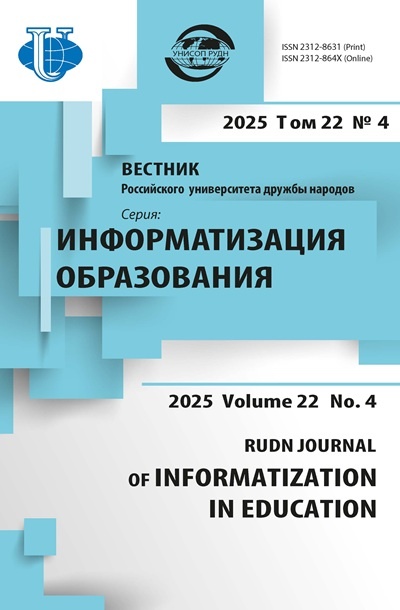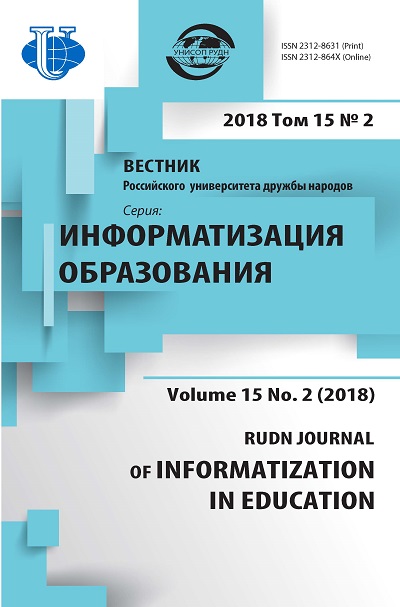PECULIARITIES OF USING INFORMATION TECHNOLOGIES IN LEARNING SOLUTION MATHEMATICAL PROBLEM
- Authors: Yaroshevich V.I.1, Safuanova A.M1, Safuanov I.S.1
-
Affiliations:
- Moscow city pedagogical university
- Issue: Vol 15, No 2 (2018)
- Pages: 221-228
- Section: ELECTRONIC LEARNING SUPPORT TOOLS
- URL: https://journals.rudn.ru/informatization-education/article/view/19154
- DOI: https://doi.org/10.22363/2312-8631-2018-15-2-221-228
- ID: 19154
Cite item
Full Text
Abstract
The article deals with the possibilities of using information technologies in teaching students to solve mathematical problems. The advantages and problems associated with the use of information technologies in teaching students to solve mathematical problems are discussed. Some ways of solving the arising problems are suggested: for example, the use of open-type problems. The attention of the reader on expediency of use of modern computer technologies in the course of training of schoolboys the decision of mathematical problems is emphasized.
Full Text
Информационные технологии дают широчайшие возможности при использовании в обучении. В соответствии с культурно-исторической концепцией Л.С. Выготского [2], компьютерные технологии можно рассматривать как орудие для построения понятий в процессе обучения. Применение компьютерных технологий может помочь в осуществлении таких подходов, как генетический подход [6; 10] и использование различных типов представления объектов по Брунеру [1]. Интерактивные игры с помощью компьютерных технологий используются при обучении математике в Сингапуре [7; 8]. В моделировании предметной деятельности наиболее полезны программы, включающие в себя динамическую геометрию, прежде всего Geogebra [3; 4] и Cinderella. Представляется целесообразным использовать современные компьютерные технологии в работе по обучению решению задач. С другой стороны, компьютерные технологии в обучении - всего лишь инструмент. При неправильном или неэффективном применении они могут привнести новые проблемы в процесс обучения. Некоторые преимущества и проблемы, возникающие при применении компьютерных технологий в обучении математике (на примере использования программы Geogebra). Преимущества: · учащиеся могут выполнять задания дома, публикуя свои решения в Интернете; · особенно хорошо использование расширенных средств визуализации геометрических понятий сказывается на преподавании в неспециализированных классах, поскольку абстрактный аппарат там не настолько развит, чтобы проводить подобные построения в уме; · использование компьютерных средств визуализации дает дополнительные преимущества для учащихся, у которых не очень хорошо получается рисовать вручную. Учащимся доставляет удовольствие видеть свои собственные красивые чертежи; · многие свойства геометрических объектов становятся гораздо наглядней при динамической реализации. Например, связь между различными коническими сечениями (кривыми второго порядка); · при недостатке часов в учебном плане по какому-либо предмету, зачастую единственным ресурсом может служить развитие межпредметных и метапредметных связей. И здесь информационные технологии выходят на первый ряд. Например, существуют богатые возможности по использованию скриптов, написанных на языке программирования, для «оживления» чертежей в среде Geogebra, что может связать уроки математики и информатики. Проблемы: · при слабом методическом обосновании использование информационных технологий привносит в процесс обучения лишь новую форму, за которой теряется смысл их использования. Так, решение задач на построение в среде Geogebra без осмысления того, какие свойства геометрических объектов были использованы, теряет изрядную долю ценности (например, при построении квадрата, вписанного в окружность, используется известный метод - строится прямая линия и перпендикуляр к ней, потом квадрат по точкам пересечения построенных линий с окружностью, но нет обоснования, почему углы прямые, а стороны равны); · только уверенное и непринужденное использование информационных технологий может обеспечить достижение поставленных педагогических целей. В противном случае их включение в учебный процесс может повлечь обратный эффект: потеряться темп урока, возникнуть недоверие и др; · может возникнуть проблема доверия: насколько то, что делается в программе, отражает реальность. · легкость построения может породить ложное ощущения легкости усвоения, хотя содержание при этом может усваиваться весьма поверхностно. Решением таких проблем может послужить разработка заданий, которые бы «зацепляли» учащихся и заставляли бы их вникнуть более глубоко в суть изучаемых явлений. Например, дополнение одной сложной «эффектной» задачи цепочкой предварительных задач, которые бы обосновывали используемые построения, их корректность и уместность. Задачи открытого типа [5; 9] могут служить для развития математической креативности и строгости математического языка. Особенность геометрических задач открытого типа заключается в том, что по построению или чертежу можно провести анализ, поиск закономерностей или отношений. Для использования задач открытого типа в рамках учебного процесса можно, в частности, просто заменить формулировки в традиционных задачах на доказа- тельства. Например, пусть даны параллелограмм и луч, как биссектриса одного из его углов. Требуется доказать, что длина отрезка, являющегося продолжением одной из сторон до пересечения с проведенным лучом, равна разности длин сторон параллелограмма. В измененной формулировке она может звучать так: «В параллелограмме ABCD луч CE - биссектриса угла BCD и EF - биссектриса внешних углов в точке С. Какие соотношения могут быть найдены среди получившихся отрезков, углов и треугольников?» В новой формулировке первоначальное утверждение могут самостоятельно предложить учащиеся. Сначала построим параллелограмм. Для этого выберем произвольные три точки A, B и C, не лежащие на одной прямой и соединим две из них отрезками (рис. 1). Проведем две параллельные построенным отрезкам прямые и на пересечении из отметим точку D - четвертую вершину параллелограмма. Соединим вершины A и D, С и D отрезками, вспомогательные прямые спрячем. Такое построение параллелограмма позволит в будущем его свободно модифицировать, перемещая опорные вершины A, B и С. Построим биссектрису угла ВСD и на пересечении с прямой, являющейся продолжением стороны AB отметим точку E (рис. 2). Построим биссектрису внешнего угла в точке C и на пересечении ее с продолжениями сторон AB и AD отметим точки E′ и F′. В такой форме схему уже можно публиковать, как интерактивный чертеж, и выдавать учащимся для самостоятельного исследования. Рис. 1. Построение двух отрезков биссектрисы угла ВСD Рис. 3. Построение биссектрисы внешнего угла в точке C 224 ЭЛЕКТРОННЫЕ СРЕДСТВА ПОДДЕРЖКИ ОБУЧЕНИЯ Дополнительно можно разместить на чертеже текстовые элементы, для отображения информации о длинах интересующих нас объектов. Модифицируя построенный параллелограмм, двигая опорные вершины A, B и С, можно наблюдать, как изменяются значения длин интересующих нас отрезков (рис. 4). Рис. 4. Модифицирование построенного параллелограмма Кроме того, представляет интерес решение планиметрических задач в программах динамической геометрии с помощью выхода в стереометрию (с использованием идей фузионизма). В настоящее время разрабатывается эксперимент для реализации этих идей в процессе обучения учащихся 6-7 классов экспериментальной ОАНО «Новая школа» (Москва).
About the authors
Vasil Igorevich Yaroshevich
Moscow city pedagogical university
Author for correspondence.
Email: vyaroshevich@gmail.com
post-graduate student, department of higher mathematics and methods of teaching mathematics, Moscow city pedagogical university
Sheremet’evskaja str., 29, Moscow, Russia, 127521Alina M Safuanova
Moscow city pedagogical university
Email: ngpis@rambler.ru
post-graduate student, chair of higher mathematics and methods of teaching mathematics, Moscow city pedagogical university
Sheremet’evskaja str., 29, Moscow, Russia, 127521Ildar Surenovich Safuanov
Moscow city pedagogical university
Email: safuanov@yahoo.com
doctor of pedagogical sciences, full professor, professor of chair of higher mathematics and methods of teaching mathematics, Moscow city pedagogical university
Sheremet’evskaja str., 29, Moscow, Russia, 127521References
- Bruner J. Psixologiya poznaniya [Psychology of knowledge]. M.: Progress, 1977. 413 p.
- Vygotsky L.S. Myshlenie i rech [Thinking and speech]. Moscow: Labirint, 1986. 352 p.
- Gromova E.V., Safuanov I.S. Obuchenie ponyatiyu funkcii v osnovnoj shkole s pomoshhyu kompyuternyx texnologij [Teaching of the concept of function at primary school with the help of computer technology]. Vestnik Moskovskogo gorodskogo pedagogicheskogo universiteta. Serija «Informatika i informatizacija obrazovanija» [Bulletin of the Moscow city pedagogical university. “Informatics and Informatization of Education” series]. 2013. No. 1 (25). Pp. 91—98.
- Gromova E.V., Safuanov I.S. Primenenie kompyuternoj matematicheskoj programmy geogebra v obuchenii ponyatiyu funkcii [implementation of the computer math program Geogebra in teaching the concept of function]. Obrazovanie i nauka [Education and science]. 2014. No. 4 (113). Pp. 113—131.
- Safuanov I.S. Otkrytyj podxod k obucheniyu matematike [Open approach to teaching mathematics]. Universitety v sisteme poiska i podderzhki matematicheski odarennyx detej i molodezhi [Universities in the system of search and support of mathematically gifted children and youth]: materialy i vserossijskoj nauchno-prakticheskoj konferencii. Maikop: ASU, 2015. Pp. 126—130.
- Safuanov I.S. Teoriya i praktika prepodavaniya matematicheskix disciplin v pedagogicheskix institutax [Theory and practice of teaching mathematical disciplines in pedagogical institutes]. Ufa: Magrifat, 1999. 107 p.
- Safuanov I.S., Atanasyan S.L. Matematicheskoe obrazovanie v singapure: tradicii i innovacii [Mathematics education in Singapore: tradition and innovation]. Nauka i shkola [Science and school]. 2016. No. 3. Pp. 38—44.
- Safuanov I.S., Polikarpov S.A. «Singapurskaya matematika»: shkolnye uchebniki [“Singapore mathematics”: school textbooks]. Nizhegorodskoe obrazovanie [Nizhegorodskoe obrazovanie]. 2016. No. 1. Pp. 32—39.
- Safuanova M.A., Safuanov I.S. «Otkrytyj podxod» i «issledovanie urokov» puti sovershenstvovaniya matematicheskogo obrazovaniya [“Open approach” and “research lessons” ways of improvement of mathematical education]. Nizhegorodskoe obrazovanie [Nizhegorodskoe obrazovanie]. 2016. No. 2. Pp. 146—150.
- Safuanov I.S. The genetic approach to the teaching of algebra at universities // International Journal of Mathematical Education in Science and Technology. 2005. Vol. 36. No. 2–3. Pp. 255— 268.
Supplementary files















